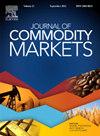商品市场下滑:左尾事件中的系统风险和溢出效应
IF 4.5
4区 经济学
Q1 BUSINESS, FINANCE
引用次数: 0
摘要
我们采用最先进的方法:成分指数短缺(CES)、量子矢量自回归(QVAR)和风险中的因果关系,研究左尾事件期间商品网络的系统性风险和溢出效应。我们的分析侧重于五类商品:能源(原油、取暖油、天然气、煤炭)、基本金属(铝、铜、镍、锌)、黑色金属(铁、钢)、贵金属(金、钯、铂、银)和其他(橡胶)。在所有使用的模型中,我们始终发现能源商品和贵金属,以及作为独立商品的铜,是系统风险最大的一组。因此,建议包含这些商品的投资组合更加谨慎地进行分散投资,以降低系统性因素带来的风险。这可能需要额外关注贵金属,因为它们通常被视为避险资产。加快实施促进以绿色替代品取代化石能源的法规,有助于管理商品市场的系统性风险,同时也有利于全球的可持续发展。最后,研究结果表明,与 COVID-19 和俄乌战争的影响相比,以巴冲突对系统风险和溢出效应的影响有限。本文章由计算机程序翻译,如有差异,请以英文原文为准。
Commodity market downturn: Systemic risk and spillovers during left tail events
We investigate systemic risk and spillovers in the commodity network during left-tail events using state-of-the-art methodologies: the Component Exponent Shortfall (CES), Quantile-Vector Autoregression (QVAR) and Causality-in-Risk. Our analysis focuses on five commodity groups: Energy (Crude Oil, Heating Oil, Natural Gas, Coal), Base Metals (Aluminum, Copper, Nickel, Zinc), Ferrous Metals (Iron, Steel), Precious Metals (Gold, Palladium, Platinum, Silver), and Others (Rubber). Across the models utilized, we consistently find that energy commodities and precious metals, along with copper as a standalone commodity, represent the most systemically risky group. Thus, portfolios incorporating these commodities are advised to implement more careful diversification to mitigate risks stemming from systemic factors. This may require additional attention to precious metals, as they are often considered safe-haven assets. Expediting the implementation of regulations that promote the replacement of fossil energy sources with green alternatives could be instrumental in managing systemic risk in the commodity market while also facilitating global sustainability. Finally, the results show that the impact of the Israeli-Palestinian conflict on both systemic risk and spillovers has been limited compared to the effects of COVID-19 and the Russia-Ukraine war.
求助全文
通过发布文献求助,成功后即可免费获取论文全文。
去求助
来源期刊

Journal of Commodity Markets
Multiple-
CiteScore
5.70
自引率
2.40%
发文量
53
期刊介绍:
The purpose of the journal is also to stimulate international dialog among academics, industry participants, traders, investors, and policymakers with mutual interests in commodity markets. The mandate for the journal is to present ongoing work within commodity economics and finance. Topics can be related to financialization of commodity markets; pricing, hedging, and risk analysis of commodity derivatives; risk premia in commodity markets; real option analysis for commodity project investment and production; portfolio allocation including commodities; forecasting in commodity markets; corporate finance for commodity-exposed corporations; econometric/statistical analysis of commodity markets; organization of commodity markets; regulation of commodity markets; local and global commodity trading; and commodity supply chains. Commodity markets in this context are energy markets (including renewables), metal markets, mineral markets, agricultural markets, livestock and fish markets, markets for weather derivatives, emission markets, shipping markets, water, and related markets. This interdisciplinary and trans-disciplinary journal will cover all commodity markets and is thus relevant for a broad audience. Commodity markets are not only of academic interest but also highly relevant for many practitioners, including asset managers, industrial managers, investment bankers, risk managers, and also policymakers in governments, central banks, and supranational institutions.
 求助内容:
求助内容: 应助结果提醒方式:
应助结果提醒方式:


